Wave Storms: Their Effects on Surfboard Performance
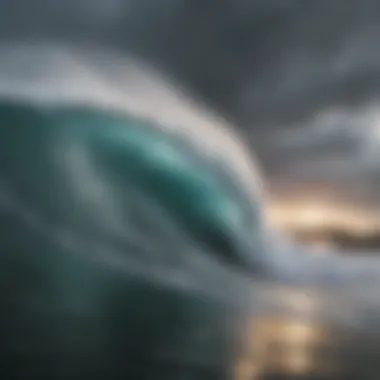
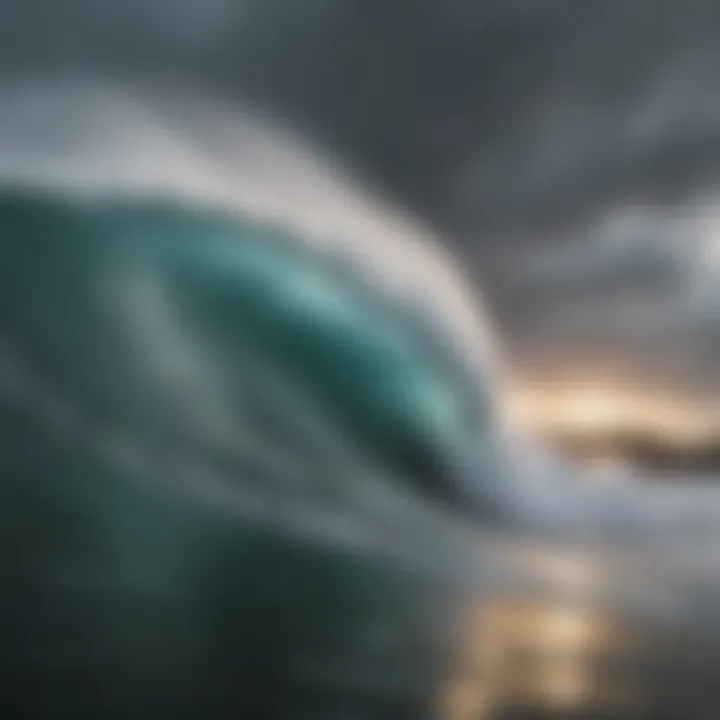
Intro
Waves are the heartbeat of surfing, especially when storms roll in and toss unpredictability into the mix. These powerful surges can whip up conditions that are both thrilling and treacherous. Understanding the relationship between wave storms and surfboard performance helps surfers navigate these wild waters. The dynamics at play are not just an abstract concept; they impact everything from how a surfer rides the wave to how well their surfboard can handle the strain. This article brings clarity to those dynamics, with an emphasis on surfboard reviews, techniques, and the unique challenges posed by stormy seas.
Surfboard Reviews
When it comes to surfing, the right board can make all the difference, especially under the pressure of intense wave conditions. From beginners learning to stand up to pros carving out epic turns in choppy surf, understanding the various types of surfboards can enhance performance and safety.
Types of Surfboards: An Overview
Surfboards come in many designs, each tailored to meet specific needs and conditions. Knowing what each board offers is crucial for surfers looking to optimize their ride.
- Shortboards: Well-suited for maneuverability and speed in steep wave faces. Ideal for advanced surfers who thrive on performance.
- Longboards: Great for beginners seeking stability. They allow for smoother paddling and are excellent for catching smaller waves.
- Fish: Wider and shorter, these boards provide a buouncy ride and are excellent in choppy waters, making them a favorite in storm conditions.
- Gun: Built for big waves, guns boast length and thickness to navigate heavy surf effectively. They can handle the forces of storm waves that would challenge other boards.
- Minimal: A bridge between longboards and shortboards. They offer the relaxed feel of a longboard while keeping some of the maneuverability of shorter variants.
Best Surfboards for Beginners and Pros
Choosing the right board depends on skill level and the nature of the waves. Here are some suggestions:
For Beginners:
- Soft-top Longboards: Great for stability. They are soft on falls and easy to paddle.
- Mini Mal: Offers a balance between performance and ease of use, perfect for new surfers.
For Experienced Surfers:
- Shortboards: For those looking to perform tricks and ride the most challenging waves.
- Gun: An essential for stormy conditions, helping experienced surfers tackle big swells safely.
"The right surfboard under your feet can mean the difference between riding a wave and wiping out in furious waters."
Surfing Techniques
Mastering storm surf requires not only the right board but also the right techniques. Conditions can vary widely, and being prepared can help mitigate danger and maximize enjoyment.
Essential Techniques for Beginners
For those just starting, focusing on the basics is key. Here are some fundamental techniques:
- Paddling: Efficient paddling is crucial. Use your whole body, not just your arms, to catch waves.
- Positioning: Learn where to sit on the board; too far back can slow you down, while too far forward can lead to nosedives.
- Pop-ups: Practice the pop-up motion on land. This will make you more comfortable when it’s time to stand up on the wave.
Advanced Maneuvers for Experienced Surfers
For the seasoned surfer, storm conditions can open up a newer level of riding. Here are a few advanced maneuvers:
- Bottom Turns: Essential for gaining speed as you prepare for your next move.
- Cutbacks: Turning back towards the wave face can help regain speed and control.
- Air Maneuvers: With the right wave conditions, airborne tricks can be exhilarating, but they require precision.
Understanding Wave Storms
Wave storms play a pivotal role in shaping not only the ocean landscape but also the experience and performance of surfers navigating those tumultuous waters. Understanding wave storms is crucial for anyone involved in surfing, as it lays the groundwork for comprehending how these dynamic forces impact surfboard performance, rider safety, and overall surfing experience.
The essence of wave storms lies in their capability to generate large, powerful waves driven by sustained winds. These waves aren’t just mere bumps on the water; they come with their unique challenges and thrills. For surfers, knowing how to interpret these conditions can mean the difference between an exhilarating ride and a precarious wipeout.
Moreover, the study of wave storms opens a window into various elements that influence wave characteristics, such as wave formation, energy transfer, and their size and frequency characteristics. By grasping these concepts, surfers can make more informed decisions when selecting surfboards suited to specific conditions and refining their techniques to adapt to the powerful forces at play.
What is a Wave Storm?
A wave storm is characterized by a significant increase in wind speed and its duration, producing highly organized and large waves. These storms can occur in various oceanic regions and are often associated with weather systems like hurricanes or extratropical cyclones. The impact of wave storms can extend beyond the ocean, influencing coastal erosion, marine ecosystems, and local economies dependent on surfing tourism.
Understanding what constitutes a wave storm enables surfers and instructors to anticipate conditions. As a result, they can prepare adequately, whether that's selecting the appropriate surfboard, understanding safety measures, or developing skills and techniques to harness the power of these waves rather than being overwhelmed by them. This knowledge fosters a deeper connection and respect for the ocean's unpredictable nature.
The Anatomy of Storm Waves
Wave Formation
Wave formation occurs when wind energy is transferred to the surface of the ocean. It begins with the friction between the moving air and water, giving rise to ripples that can develop into larger waves. The visibility of these waves often indicates the storm's power. A key characteristic of wave formation during storms is the consistency and symmetry of the waves, which allows for a smoother ride when surfing.
Unique Feature: The ability of storms to create swells that can travel long distances enhances the predictability of wave patterns in certain areas, especially for those familiar with local spots.
However, larger storm waves can be inherently dangerous due to their unpredictable behavior and the energy they unleash, which can lead to life-threatening situations for inexperienced surfers.
Energy Transfer
The process of energy transfer in waves is truly fascinating. As wind blows over the ocean, it imparts its kinetic energy to the water, generating waves that accumulate more energy as they travel. The intensity of a storm is often reflected in the energy contained within these waves.
Advantages: This energy is what surfers seek, as powerful waves offer thrilling rides. However, it can quickly become a double-edged sword. The same energy can make for a challenging environment, with risks of injury increasing significantly for those unable to navigate the changing dynamics.
Size and Frequency
The size and frequency of wave storms determine their surfability and safety margins. Larger waves appear with more force and frequency, representing both an undeniable challenge and a thrilling adventure for surfers.
Key Characteristic: A vital element of size is how it influences surfing choices; seasoned surfers aim for specific size ranges depending on their proficiency and the surfboard’s design.


Unique Feature: Bigger waves tend to be less frequent, offering a mixed bag. On one hand, the rarity of massive swells can entice competitive surfers, while on the other, the window of safety shrinks.
These aspects highlight the importance of understanding storm waves in detail. From how they’re formed to studying the energy transfer and size implications, surfers can better prepare themselves for the unpredictable ballet that is storm surfing.
The Physics Behind Surfing Storm Waves
Understanding the physics of surfing storm waves is essential for surfers, designers, and anyone interested in the dynamics of oceanic phenomena. The interplay nature creates during storms reveals intimate details about wave behaviors, which can affect a surfer's performance significantly. When one grasps wave dynamics, it's possible to predict how surfboards will respond under varying conditions, thus optimizing the surfing experience.
Wave Dynamics
Breaking Waves
Breaking waves serve as the grand spectacle of storm conditions. They are characterized by their sudden transformation from a flat, rolling wave into a towering wall of water that breaks at a point known as the breaking zone. This zone can vary based on several factors, including the wave's speed, angle, and the depth of the water below.
What makes breaking waves particularly interesting is their potential energy that transforms into kinetic energy as they cascade shoreward. They create powerful forces that can challenge the best surfers when riding. The strength and height of a breaking wave can lead to a thrilling ride or a daunting wipeout, depending on a surfer's skill and confidence. While exhilarating, the unpredictable nature of these waves necessitates a careful approach. Surfers must respect their strength while harnessing their power.
Speed and Momentum
Speed and momentum are crucial characteristics when analyzing storm waves. As storms develop, winds push waves over vast expanses of water, increasing their speed significantly. Quick-moving waves mean surfers must anticipate changes and react swiftly.
The momentum of a wave can propel a surfer forward, providing the necessary push to perform impressive maneuvers. However, faster-moving waves can also be unforgiving, catching inexperienced surfers off guard. Understanding the relationship between wave speed and momentum is essential as it dictates how and when to catch a wave, particularly in turbulent storm conditions.
Impact on Surfboards
The impact of storm waves on surfboards is a topic of great importance. Surfboards are engineered to endure the punishment of the ocean, yet the forces exerted by storm waves can be extreme. A typical surfboard may not withstand the impact of a heavy wave without incurring damage.
Diverse surfboard materials and designs cater to these demanding conditions, with more resilient options like epoxy taking precedence over traditional materials. Washed-up boards often serve as evidence of the brutal waves; it highlights the necessity for durable designs. Surfers must choose or design their boards to absorb shock while offering stability against the powerful forces at play in storm situations.
Surfboard Interaction with Water
The understanding of how surfboards interact with water is fundamental for surfers targeting optimal performance while storm surfing. Several aspects play a role in this interaction, from hydrodynamics to the principles governing buoyancy and drag.
Hydrodynamics
At its core, hydrodynamics refers to the behavior of water as it interacts with solid objects—in this case, the surfboard. The shape and contour of a surfboard influence how effectively it can cut through water, dramatically affecting riding efficiency.
A well-designed board minimizes resistance and enhances glide, which is crucial when navigating through turbulent waves. A surfboard that can glide efficiently saves energy and allows for longer rides. In storm conditions, poor hydrodynamics can lead to a loss of speed and increase fatigue, which is far from ideal.
Buoyancy and Stability
Buoyancy and stability are two sides of the same coin. An effective surfboard must maintain buoyancy to stay afloat while providing enough stability to prevent tipping. Factors like board volume and shape contribute significantly to how a surfer balances on their board.
In storm conditions, where waves can be chaotic, buoyancy is critical. Boards with an appropriate volume help prevent surfers from diving into the water too quickly, making it easier to ride over those powerful waves. Unfortunately, if a board is too buoyant or improperly designed, it might not be stiff enough to hold steady, leading to instability.
Drag Reduction Techniques
Minimizing drag is a key element in increasing performance while surfing in stormy weather. Various techniques can help achieve this; one common method includes the use of fins designed to cut through waves efficiently, reducing water resistance.
Innovative surfboard shapes have also emerged to counteract drag by improving hydrodynamics. Streamlined designs that allow for a smooth bottom curve attract surfers looking to optimize their experience. While these tricks can drastically improve performance, the downside lies in possible compromises in other areas like stability—a delicate balance for any surfer to navigate.
"In storm conditions, the ocean is both a canvas and a battleground for surfers. Understanding the physics behind it not only empowers them but ensures a safer journey through the chaos."
Designing Surfboards for Extreme Conditions
When it comes to tackling stormy waves, understanding how surfboards are crafted can make or break the surfing experience. The design of a surfboard for extreme conditions isn’t just a matter of aesthetics; it influences performance, stability, and overall safety. In the realm of big wave surfing, every detail plays a pivotal role in ensuring that surfers can meet the demands of powerful waves. This section explores various aspects of surfboard design including materials, shapes, and dimensions, providing insights that can help both novice and seasoned surfers optimize their gear for storm surf.
Materials Used in Surfboard Construction
Epoxy vs. Polyester
Epoxy and polyester are the two main types of materials used for making surfboards, each presenting their own advantages and drawbacks. In rough waters, epoxy tends to be favored for its lightweight properties and sturdiness. It’s more resistant to dings, which can be a lifesaver when you’re navigating through a storm. On the flip side, polyester is often seen as easier to repair. Its popularity stems from its classic feel and that it tends to soak up paint and gloss finishes better than epoxy, allowing for more creative designs.
Ultimately, the choice between epoxy and polyester boils down to personal preference and specific surfing needs, but for storm conditions, epoxy's resilience is hard to overlook.
Reinforcement Techniques
When it comes to making surfboards capable of handling stormy surf, reinforcement techniques play a crucial role. Additional layers of fiberglass or carbon fiber can enhance the board's overall durability. Using these materials provides a solid backbone that helps maintain the board’s integrity when it faces fierce waves. Furthermore, techniques like rail reinforcement become vital for preventing the board from flexing too much under pressure.
This added strength can be the difference between a board that survives a wipeout and one that doesn’t. Reinforcements can, however, make the boards slightly heavier, so finding a balance is key.
Environmental Considerations
The surfing community is becoming more aware of the environmental impacts caused by surfboard production. New materials, such as bio-resins and recycled foam, are now gaining traction as they aim to lessen the ecological footprint of surfboard manufacturing. By choosing more sustainable materials, sticker-shock aside, surfers can contribute towards preserving ocean health.
While these greener options typically come at a higher price, they can last just as long and offer similar performance levels compared to traditional materials. Thus, embracing environmental considerations is essential for those who care about both surf performance and the planet.
Shapes and Dimensions for Storm Surf
Length and Width
The dimensions of a surfboard have a direct impact on how it performs in challenging conditions. Longer boards usually provide better paddling speed and glide, making them beneficial when catching steep waves. However, wider boards tend to offer more stability which is crucial if you're dealing with choppy waters. This variance in length and width allows for adaptability in different storm conditions.
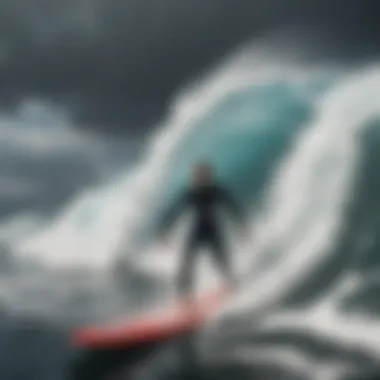
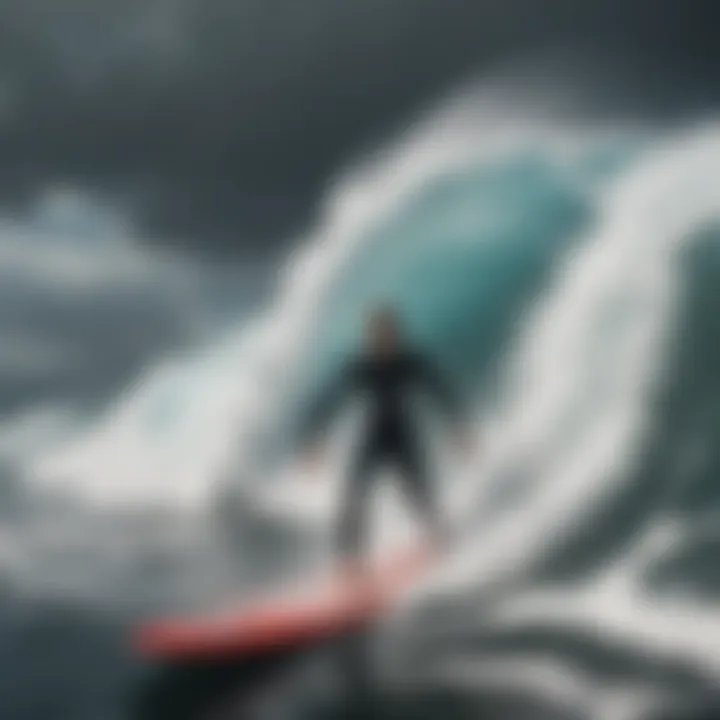
Surfers often find that a board with a bit more length helps maintain control during a powerful ride, though it can be more unwieldy for tricks. In a storm, having a strategically sized board can mean the difference between maintaining composure or getting knocked around.
Nose and Tail Design
The shape of the nose and tail can significantly alter a board's performance in storm surf. A pointed nose is designed to slice through waves, providing the surfer the ability to negotiate more significant swells. Conversely, a wider tail offers better lift during take-off and enhanced maneuverability. Furthermore, tail designs such as squashtail or pin-tail can impact how a board interacts with the wind and waves, making it essential to choose a design that complements one’s surfing style.
For storm conditions, opting for a nose that allows ease in catching fast waves, paired with a tail that keeps you agile, is advantageous.
Volume Distribution
Volume distribution across a surfboard is another critical aspect worth considering. Boards with a bit more volume tend to float better, which can help in intense wave situations. Proper distribution allows for both buoyancy and ease when paddling.
Too much volume, however, might hinder maneuverability. The challenge lies in achieving a balance where a board has enough volume to support the surfer during heavy waves while not sacrificing the sleekness required for swift turns.
By giving careful thought to volume distribution, surfers can maximize their handling ability in the stormy seas, transforming daunting conditions into rewarding rides.
Techniques for Surfing During Storms
Surfing during stormy weather is no walk in the park. It's a complex dance of skill, instinct, and knowledge of the chaos. Mastering the techniques of surfing during storms means the difference between riding the wave of a lifetime and getting caught in a dangerous situation. As surfers delve into storm conditions, their understanding of wave behavior, effective paddling, and the subtleties of board movement become vital.
Reading the Waves
Identifying Safe Spots
First off, knowing where to surf is crucial. Identifying safe spots amidst churning waves can determine not just the quality of a ride, but also the safety of the surfer. In the heat of a storm, familiar landmarks or geological features can help you find shelter from the harshest wind and wave action.
The key characteristic here is the awareness of your environment. Sharp rocks or shifting currents can quickly become hazards. Utilizing local knowledge, and even apps that track wave patterns, can set surfers on a safer path, one that leads to adrenaline without unnecessary risk.
A unique feature of identifying safe spots is that these areas can shift before and during a storm. What might be a calm corner today could turn treacherous tomorrow. Therefore, constant vigilance and adaptability become your best allies.
Understanding Rip Currents
Rip currents are sneaky but often significant dangers during storms. Understanding these currents and how they form is essential for ensuring your safety. A rip current isn’t just a fast water race; it’s a natural phenomenon that can pull even experienced surfers away from shore.
The critical point is that knowledge of rip currents allows surfers to navigate the complexities of storm surfing. Recognizing the visual cues—like changes in water color or surface texture—can be a lifesaver.
However, it’s crucial to balance this knowledge with respect for the ocean's power. Overconfidence can lead one into tricky waters, both figuratively and literally.
Wave Timing
Another key element is correctly timing your engagement with the waves. Wave timing involves predicting when the waves will peak and break, which can vary widely depending on storm conditions. This understanding enables surfers to line up for optimal rides and avoid being in the wrong place at the wrong time.
The key characteristic of wave timing is that it requires both skill and intuition. Experienced surfers often develop a sixth sense, allowing them to feel the rhythm of the ocean. Knowing when to paddle hard and when to hold back can mean catching your moment or wiping out in a tough spot.
Wave timing also varies greatly with the size and frequency of storm swells. Timing techniques can keep surfers in the sweet spot, maximizing their chances of a successful ride.
Paddling and Positioning
Effective Paddling Techniques
When the waves are big, efficient paddling becomes an art. Effective paddling techniques involve not just raw strength, but also understanding water flow and body mechanics. The key to mastering paddling is leveraging your body weight instead of relying solely on arm power.
A unique feature of this technique is that it reduces energy expenditure over time. This means less fatigue when catching waves, which is essential when the ocean is in a violent mood. Incorporating long, smooth strokes can create a glide effect, cutting through the water significantly.
Positioning for Takeoff
Positioning for takeoff is about place and angle—where you sit in anticipation of a wave and how you align your body can dictate your ride. The best surfers can feel when a wave is about to break; positioning themselves slightly ahead of the curve can help them catch it at just the right moment.
The key characteristic of this technique is awareness. Surfers need to become attuned to their surroundings, but there’s also a requirement for physical prowess. Making quick adjustments while staying balanced is no small feat.
However, getting this positioning wrong can lead to an unsettling wipeout or a missed opportunity, hence practicing this under varying storm conditions can improve adaptability.
Posture Adjustments
Posture adjustments can be a game-changer in storm surfing. Proper body alignment can enhance balance while maneuvering through choppy waters. The key characteristic of effective posture is maintaining a low center of gravity, which ensures stability on an uneven surfboard.
This adaptability also means acknowledging when to shift weight forward or backward, depending on the wave dynamics. The unique feature here is that adjusting posture isn't just about riding the wave; it's about responding to its unpredictability. Lack of proper posture can result in falls or losing control while riding the wave.
Riding and Maneuvering
Balancing Techniques
Once surfers are up and riding, balancing techniques kick in. Staying centered on the surfboard becomes critical, especially during storm conditions where waves can shift unexpectedly. Maintaining balance in these turbulent waters is about fine-tuning weight distribution.
The key characteristic of these techniques is that they require both practice and instinct. Moments of unexpected turbulence can throw even experienced surfers off balance. Some riders swear by the practice of bending knees wider for lower stability, while others find shifting toes back and forth gives the needed control.
Tricks and Techniques for Storm Surf
In turbulent waters, riders often utilize tricks that capitalize on the chaos. Advanced techniques evolve as surfers learn to read storm waves, turning perilous situations into exhilarating rides. Key characteristics of these techniques involve precision and timing, matched with a healthy understanding of safety.
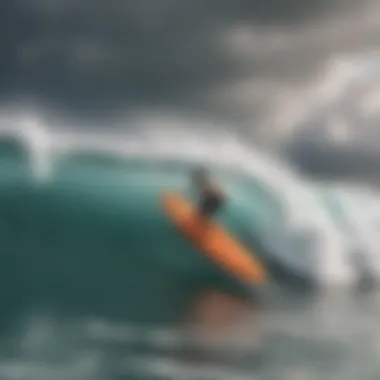
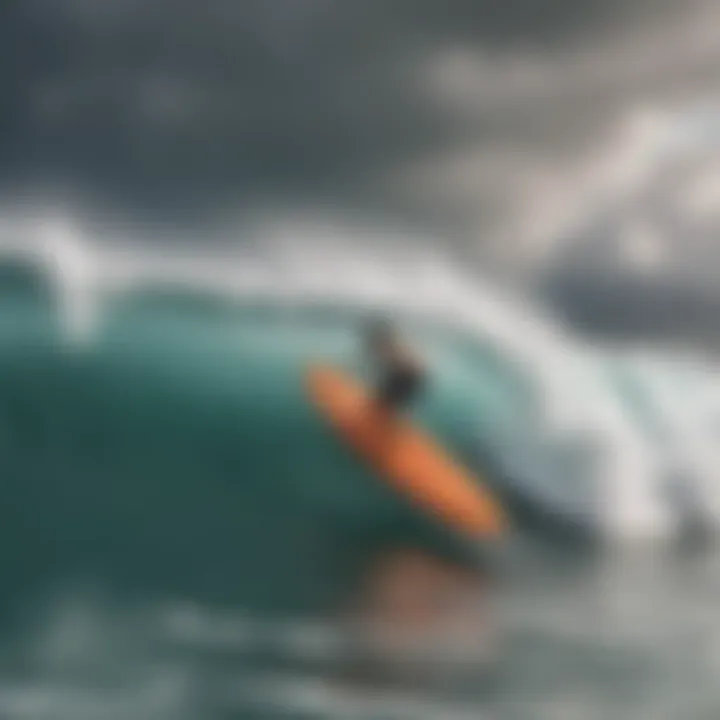
Participating in advanced tricks can elevate a surfer's experience immensely, but it also requires respecting limits. Beginners should start with fundamental tricks that only slightly challenge their technical skills.
Conserving Energy
Finally, conserving energy in turbulent situations is essential for maintaining endurance during lengthy sessions. Knowing when to paddle actively versus floating can make all the difference. The key characteristic of energy conservation is awareness of your body’s limits and rhythm.
Surfers often find that a blend of powerful strokes and relaxed gliding keeps them in the game longer. However, it also means not pushing beyond one's capacity during crucial moments in a ride. Balancing efforts and conserving reserves ensures enough stamina to ride the peaks consistently.
Safety Considerations in Storm Surfing
Storm surfing can be both exhilarating and perilous. Therefore, understanding safety considerations is crucial for surfers who seek to conquer challenging waves. The turbulent waters and unpredictable conditions often associated with wave storms demand that surfers arm themselves with knowledge and preparation. By recognizing the risks involved, being equipped with the right safety gear, and establishing emergency protocols, surfers can enjoy the thrill of storm surfing while minimizing hazards.
Identifying Risks
Environmental Hazards
When out on the ocean during stormy conditions, the element of nature can be daunting. Environmental hazards include swift currents, rogue waves, and frequently changing weather patterns. Surfers must be aware that these hazards can shift in an instant, making what seemed safe hazardous very quickly. Recognizing such risks entails understanding local conditions and being vigilant about changes. A key characteristic of environmental hazards is their unpredictability; even a skilled surfer might find themselves in dangerous situations if they don't remain alert.
Thus, for surfers, maintaining a good grasp of environmental hazards is a vital asset, especially when navigating the tumultuous nature of storm waves.
Observing local patterns can offer invaluable insight, leading to more informed decisions about when to ride and when to stay ashore.
Personal Safety Gear
Personal safety gear plays a significant role in safeguarding surfers against the rigors of storm conditions. Wearing a wetsuit, impact vest, or helmet, for example, can mitigate injuries from falls or collisions with surfboards or marine objects. The essential aspect of this gear is comfort and mobility while providing necessary protection; a bulky outfit might hinder performance, while inadequate gear may leave a surfer vulnerable. An additional feature of such gear includes buoyancy, helping to keep surfers afloat amidst turbulent waters. The benefits of investing in quality safety gear are clear.
It can significantly reduce the risk of injury and enhance confidence while tackling formidable conditions. However, a notable disadvantage is the extra weight that may slow a surfer down, particularly if the gear is not chosen wisely.
Emergency Protocols
Having emergency protocols in place is vital for fostering a safe surfing environment during storms. These protocols must be tailored to specific situations surfers may encounter on the water.
For example, establishing clear signals for when to exit the water or what to do if a surfer becomes disoriented can be life-saving. The key characteristic of effective emergency protocols is their simplicity and clarity; they should be easy to remember and act upon. This clarity encompasses unique features like designated meeting points and practices for swift rescue when needed. While these procedures can manifest as mere precautions, they can provide immense peace of mind and ensure safety even in chaotic circumstances.
Community and Sharing Experiences
Connecting with Fellow Surfers
The art of connecting with fellow surfers can be instrumental in enhancing safety during storm conditions. Sharing experiences and insights among the community fosters a culture of learning and support. This characteristic of camaraderie aids surfers in recognizing potential dangers they might overlook individually. Furthermore, by being part of a local surfing community, surfers can stay informed about weather updates and changes in surf conditions. A unique feature of this connection is the camaraderie that develops through shared challenges. While it can build friendships, it also cultivates a network of support for those seeking guidance in storm conditions. However, relying too heavily on peer advice without personal assessment can backfire; ultimately, each surfer must make their own informed decisions based on experience and knowledge.
Learning from Experienced Surfers
Learning from experienced surfers serves as an invaluable resource for newcomers and seasoned surfers alike. These individuals possess a wealth of knowledge about wave patterns and the nuances of storm conditions. Observing their techniques provides insight into navigating challenging surf and understanding environmental nuances.
The key characteristic of this learning experience is the depth of real-life encounters; stories filled with valuable lessons often have a lasting impact. A unique feature of such mentorships is the ability to cultivate essential skills without the trial-and-error approach that can prove dangerous during storm surfing. However, there may be a disadvantage in over-relying on the expertise or preferences of seasoned surfers, as their experiences may not exactly mirror another surfer's circumstances or style.
Participating in Local Events
Participating in local events can be an excellent way to deepen one's understanding of storm surfing while enhancing community ties. Events provide opportunities to share knowledge, practice skills, and raise awareness about safety measures. By focusing on shared experiences, these gatherings often highlight useful techniques for storm conditions. A significant aspect of participating in local events is the ability to gain insights directly from peers, fostering a sense of unity among surfers. One unique feature of these events is the sense of belonging they instill. Surfing can feel solitary, but togetherness during events transforms it into a communal activity. However, while these gatherings are enjoyable, they may not be accessible for everyone, depending on geographical or financial considerations.
Finale: The Future of Storm Surfing
Storm surfing captures a unique intersection of thrill and risk, and understanding its future is vital for anyone involved in the sport. The coming years not only hold promise for surfboard technology but also for the collective awareness of environmental concerns. Every surfer has a vested interest in these developments, as they could significantly shape how we engage with storm surf.
Advancements in Technology
Innovations in Surfboard Design
The evolution of surfboard manufacturing has taken great strides lately, with new materials and shapes emerging as a response to extreme conditions. For example, the advent of high-strength materials mixed with lighter cores allows boards to withstand the harsh impacts of storm waves. This lightweight construction brings an increased maneuverability that surfers need when tackling unpredictable waters.
Here, a standout feature is the hybrid foams utilized in modern surfboards. These foams boost performance while ensuring durability, letting surfers push their limits with less worry about damage. However, despite their strengths, they can sometimes compromise on certain rides, making it essential that surfers choose boards suited for their skill level and surfing style.
Predictive Technologies
Another significant aspect that is shaping the storm surf landscape is the rise of predictive technologies. Innovative forecasting tools utilize complex algorithms and real-time data to provide surfers with insights on wave size and potential danger zones. These technologies help surfers prepare better for what lies ahead. When you're out there in the ocean, having access to such information is not just an advantage; it’s a lifesaver.
What sets predictive technologies apart is their real-time updates, making surfing safer and more informed. Nevertheless, surfers must rely on their instincts along with the data, as unpredictable nature can sometimes defy predictions.
Sustainability Efforts
With climate change making the ocean increasingly volatile, sustainability in surfboard manufacturing has garnered attention. Companies are now leaning towards eco-friendly materials like bioplastics and recycled foam. These innovations strive to ensure that while surfers enjoy the waves, they also protect those very waters.
The best part? The emphasis on sustainable practices is gaining popularity among consumers, turning eco-friendly boards from a niche market into a mainstream choice in the surfing community. However, the challenge remains in sourcing these materials effectively while keeping prices reasonable for everyday surfers.
Embracing Environmental Changes
Understanding Climate Impacts on Surf Conditions
As the climate continues to shift, it undeniably affects surf conditions around the world. From changing wind patterns that create new wave formations to the increasing frequency of storms, surfers must stay informed. Recognizing these patterns equips surfers with the knowledge to adapt their techniques and lifestyles.
What’s critical here is the growing community awareness about these changes. Being informed ensures that surfers don't just react but prepare for evolving conditions. However, all this requires ongoing research and communication amongst surfers and scientists alike.
Advocacy for Ocean Conservation
The increasingly frightening state of our oceans has led to a surge in advocacy movements. Many surfing communities are actively involved in conservation efforts to preserve our oceans and coastlines for future generations. When surfers advocate for clean oceans or participate in beach clean-up efforts, they not only protect the environment but strengthen community ties.
The focus on ocean advocacy is becoming central to the identity of many surf spots around the globe. Still, the movement can feel overwhelming at times. Whether on social media or during local events, small consistent efforts from the surfing community can foster significant change.
Building a Resilient Surf Community
Amidst challenges presented by nature and climate, building a resilient surf community is essential. This encompasses supporting one another, sharing knowledge, and creating opportunities for collaboration among surfers. Whether it’s through local surf clubs or global forums, fostering connections can be the key to navigating the unpredictabilities of storm surf.
A resilient community is marked by networking and shared experiences, which can enhance skills and bring forth a wealth of knowledge. The downside, however, is the potential for divisiveness among segments of the community, which could hinder collective growth if not managed carefully.
As we advance, it’s apparent that storm surfing doesn’t exist in isolation. Each surfer’s journey is intertwined with technology, environmental awareness, and community strength. Thus, the future of storm surfing will rest not only on individual prowess but also on how well we adapt collectively.















